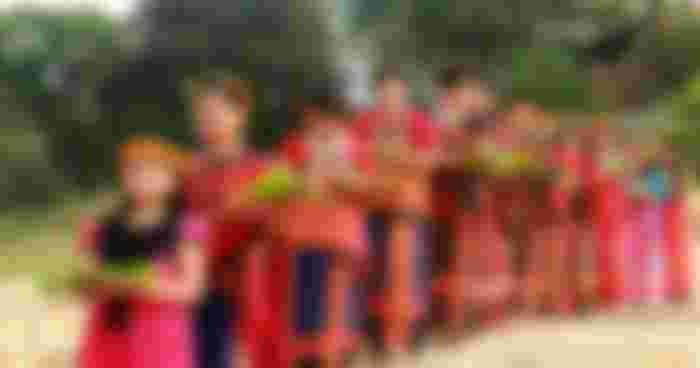Minorities of Bangladesh
Bangladesh is a country of many races, cultures, religions and languages. The large Bengali-speaking population of this country, along with the Bengalis, has long been inhabited by a number of small ethnic groups. They are different from the Bengalis in manners, ceremonies, religion, language, reforms and culture. They are an integral and inevitable part of Bangladesh.
Indigenous and Minority Ethnic: The English word Aborigines is derived from the Latin word Aborigine which means "from the beginning" which means the indigenous people living in a country are called Indigenous. Minorities, on the other hand, refer to minorities and relatively backward races or communities living alongside major nations.
Statistics of Minorities in Bangladesh: There is disagreement about the actual number of minorities in Bangladesh. According to the 1991 census, there are 29 small ethnic groups in Bangladesh. Most of them live in different hilly areas of Chittagong Hill Tracts. According to the 2001 census, the total number of tribals in Bangladesh is 3 lakh 64 thousand 85 people. However, according to the data provided by the Bangladesh Indigenous Forum, there are 45 ethnic minorities and a total of more than 20 lakh indigenous people. Notable among the small ethnic groups of Bangladesh are Chakma, Marma, Rakhine, Thanchangya, Manipuri, Garo, Hajong, Santal, Khasia etc. They have been living in the Greater Chittagong Hill Tracts, Mymensingh, Sylhet, Rangpur, Dinajpur, Panchagarh, Rajshahi, Thakurgaon, Cox's Bazar etc. for ages.
Chakmas: The Chakmas are the largest ethnic group in Bangladesh. The Chakmas call themselves Changma. They live in the greater Chittagong Hill Tracts, especially in Rangamati, Khagrachhari, Bandarban and other districts. They are again divided into small groups. They have their own social, administrative and judicial system with the king in charge. The king settled the Chakmas' customs, customs, land, revenue management, village quarrels and various other issues. The social system of the Chakmas is patriarchal. As a result, only the sons inherit the ancestral property. Although agriculture is their main livelihood, at present the Chakmas have also found a place in employment and business. Among the indigenous communities, the Chakmas have the highest literacy rate (36.8%). They are Buddhists. Their main religious and social festivals include Maghi full moon, Baishakhi full moon, Buddhist full moon, Kathin Chibar Dan, Madhu full moon, lantern flying etc. One of the biggest festivals of Chakmas is Biju festival.
Marma: The second largest community in terms of majority is the Marma. Although Marmas live in the hill districts, they are mainly residents of Bandarban. They are called Marma because they came from Myanmar. However, the word Marma comes from the word ‘Mraima’. About 1 lakh Marmas live in Bandarban. Like the Chakmas, the responsibility of social justice is in the hands of the king. Despite the patriarchal social system, Marma girls inherit the same ancestral property. They make a living by cultivating zoom, hunting river fish and crabs and making cloth, cigars etc. However, they are rapidly establishing themselves in the field of education, employment, business and other fields. The Marmaras speak their own language but use the Burmese alphabet to write. Marmaras are Buddhists. Their main religious and social festivals include Buddhist full moon, Kathin Chibar Dan, Wagyoai etc.
Thanchangya: Thanchangya is one of the small ethnic groups in Bangladesh. They live in Rangamati and Bandarban districts. Although the Thanchangyas claim to be a distinct ethnic group, anthropologists believe that they are a sub-tribe of the Chakmas. They have a lot in common with the Chakmas in terms of socio-cultural customs and traditions. The language of the Tanchangyas belongs to the Indo-Aryan language group. The Tanchangyas refer to it as 'Manabhasha'.
Garos: The Garos, one of the smallest ethnic groups in Bangladesh, live in the deep forests of Madhupur in the greater Mymensingh district, the forested areas and the hills of the Garo Hills. Besides, some Garos can be seen in Netrokona, Tangail and Sunamganj areas. Anthropologists think they are a branch of the Mongol ethnic group. The Garos prefer to identify themselves as the people of Achchik Mandi. However, those who live in the plains only identify as mandi. The social system of the Garos is matriarchal. The name of the language of the Garos is Achchik language. However, the language of the Garos living in the plains is different, their language is called Mandi language. The Garos believe in a distinct religion and religious beliefs are at the heart of their cultural festivals and rituals. The biggest religious and social festival of the Garos is the Nabanna or Wangala festival.
Rakhine: The Rakhine community is basically an ethnic group in Myanmar. Rakhines live in parts of the Chittagong Hill Tracts, Rangamati and Bandban districts. Rakhine are commonly known as Mugs. Rakhine are Buddhists. As a result, their main festivals are- Buddha's birth anniversary celebration, Baishakhi full moon, Maghi full moon etc. In addition, the Rakhine celebrate the 3-day Sangrai festival with great pomp. Men like to wear lungi, fatwa and women like to wear lungi, blouse, ornaments and flowers on their head. In Rakhine marriages, it is customary for men to pay dowry.
Manipuri: The original home of the Manipuris is in the Indian state of Manipur. They came and took refuge in greater Sylhet during the Burma-Manipur war. Manipuris are also found in Brahmanbaria and Mymensingh. As a result of linguistic and religious differences, the Manipuri community is divided into three separate sub-groups. (1) Bishnupriya, (2) Maitai, (3) Pangan. According to SIL International statistics of 2003, there are a total of 40,000 Bishnupriya Manipuris and 15,000 Maitai Manipuris in Bangladesh. The culture of Manipuris is very rich and traditional. Especially Manipuri dance is internationally acclaimed. Raspurnima is the biggest festival of Manipuris.
Hajong: Among the small ethnic groups of Bangladesh, a significant Hajong community is found in Netrokona district. Ha means soil and rust means insects. In fact, they are named Hajong because of their affinity with agriculture. About 3000 Hajongs live in Bangladesh. They have occupied a significant place in history by leading movements like Hajong Rebellion, Tebhaga Movement etc. Hajongs have their own language. The biggest festival of Hajong is 'Pak Khela' festival. Some of them are Buddhists and some are Christians. Apart from rice, fish and vegetables, young bamboo powder or meowa is their favorite food.
Santals: The Santals are one of the largest indigenous groups in East India and Bangladesh. Santals live in North Bengal of Bangladesh, especially in Dinajpur and Rangpur. The Santal community is again divided into 12 sub-tribes. They live in small mud houses. The main occupation of the Santals is agriculture. Bonga is the chief deity of the Santals. They basically worship the sun. Sohrai is the name of the annual festival of the Santals. Santal girls dance in groups in this festival. The main food of the Santals is rice. The Santals also like to eat fish, crabs, pigs, chickens, rabbits, guisaps, rats and beji. They have a special place in history due to the Santal Rebellion.
Khasias: Khasias live in the Sylhet region of Bangladesh. They prefer to stay in the deep forests near the Indian border. The Khasias living in Bangladesh belong to the Sinteng tribe. The Khasias are mainly farmers. They cultivate betel in deep forests. Due to the matriarchal society, women get married and bring grooms to their homes. Women also gain ownership of property.
Apart from the mentioned communities, some other small ethnic groups like Tripura, Khyang, Munda, Chuck, Lusai etc. live in Bangladesh.

The present situation of the minorities: Although in the past these minorities were oppressed and persecuted in various ways at the hands of the majority, but now the situation has changed. At present, the government is taking various steps including special quotas for small ethnic groups, vocational education assistance and is playing an effective role in making this backward community progress in education and culture. Indigenous communities now make a living not only by farming but also by getting higher education and working in respectable positions. Besides, special facilities are being provided to them in order to bring them forward in all fields like business, politics, industry-culture etc.
Minority communities living in Bangladesh are citizens of this country. So it is our national responsibility to show respect to them and preserve their culture, history, heritage. At present, if some initiatives are taken, their history, heritage, customs, way of life, etc. need to be researched on a wider scale and appropriate and effective steps should be taken to preserve them.
